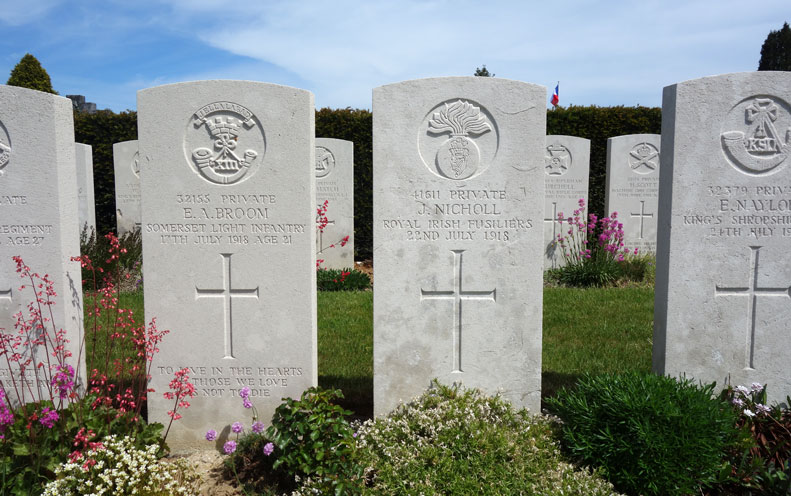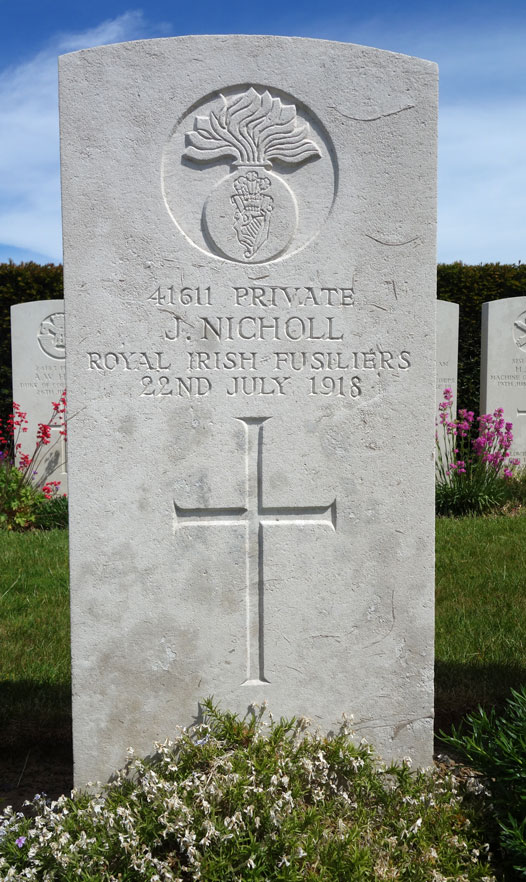![]() In memoriam
In memoriam ![]()
Private John William Nicholl
John William Nicholl was born on 2 July 1894 at Mullycavan, Clones, County Fermanagh, the fourth of five children of farmer James Nicholl and his wife Jane (formerly Benson). After his elderly father died in 1897 and his mother three years later, John and his siblings were brought up by relatives. At the time of the 1911 Census he was living with farmer Robert Nicholl and his family at Tullyard, County Tyrone, where he worked as an agricultural labourer.
Nicholl enlisted in the 6th (Inniskilling) Dragoons Service Squadron at Enniskillen between 13 and 19 October 1914 (No.UD/47). He embarked for France with his squadron on 6 October 1915. At the time they were serving as divisional cavalry to the 36th (Ulster) Division.
In June 1916 the Inniskilling squadron came together with C and F Squadrons of the North Irish Horse to form the 2nd North Irish Horse Regiment, serving as corps cavalry to X Corps. Nicholl was wounded the following month in the early days of the Battle of the Somme. The Regimental diary for 5 July 1916 stated:
Orders were received from A.P.M. 36th Division at 9 am for the two troops dismounted to report to Capt O'Neill at Lancashire Dump for salvage duty. They carried out this duty bringing in equipment, rifles etc till 1 pm. The men had dinner and were just turning out again when Lieut Seymour received orders from 36th Division to return to Regtl Head Quarters. The men had just started to saddle up when a heavy bombardment of both high explosive, shrapnel & machine guns was concentrated on the Wood. The intensity of the fire necessitated Lt Seymour giving orders for the men to take shelter in some old dugouts & trenches close by. The bombardment lasted for 3/4 of an hour & then slackened but did not entirely stop. Up to now one horse was killed & four wounded. The men were then ordered to saddle up & lead their horses thro' Wood out on to the road and were waiting for the others to join up when the bombardment opened much heavier than previously especially on that part of the road where the men were waiting. Lt Seymour moved off up the road leaving 2/Lt Matthews & Sergt McIlvoy to round up the stragglers in the wood, as by this time horses were very restive and almost unmanagable. Lt Seymour with his party had reached about 1 mile along the road & turned down a lane leaving the horses in charge of Sergt Quinn. Almost immediately a heavy fire was brought to bear on the horses and Sergt Quinn was wounded. The horses stampeded in every direction, some back to Aveluy Wood. Eventually Lt Seymour was able to round up most of this party & got to Senlis. Lieut Matthews & Sergt McIlroy remained behind. Our losses numbered 16 horses killed or wounded and 2 missing. 2/Lt Matthews was wounded severely in the knee from high explosive and Pte Downes, Nicholl, Gourley wounded (hosp) and Ptes Buchanan, 195 Campbell, Totton, 105 Craig, Cpl Dickson, 209 Robinson slightly wounded (duty).
Nicholl recovered from his wounds and returned to his squadron.
In August 1917 orders came that the 2nd North Irish Horse Regiment would be dismounted and the men transferred to the infantry. Nicholl was one of 70 men given the job of conducting the regiment's horses to Egypt. They embarked from Marseilles on board HMT Bohemian on 25 August. After a month at Alexandria they returned to France, through Italy. On 5 October they arrived at the 36th (Ulster) Division Infantry Base Depot at Harfleur for infantry training.
After just a few days they were posted to the 9th (Service) Battalion, Royal Irish Fusiliers – renamed the 9th (North Irish Horse) Battalion, joining it in the field at Ruyaulcourt on 12 October. Nicholl was issued regimental number 41611 and posted to C Company. He probably saw action with the battalion during the Battle of Cambrai in November and December 1917.
Nicholl was one of the many of the 9th Battalion listed as missing following the retreat from St Quentin from 21 to 28 March 1918 during the German spring offensive. In fact he had been captured near Nesle on 27 March. He died while a prisoner of war on 22 July 1918 in the Bavarian War Hospital, Hautmont, as a result of complications following an operation for tonsillitis.
Private Nicholl was buried at the Hautmont Communal Cemetery, Nord, France, grave V.B.10. The gravestone inscription reads:
41611 PRIVATE
J. NICHOLL
ROYAL IRISH FUSILIERS
22ND JULY 1918

Images Copyright © Phillip Tardif with all rights reserved as set out in this Use of Material policy.
This page last updated 6 February 2023.

